
Question Number 3695 by Rasheed Soomro last updated on 19/Dec/15
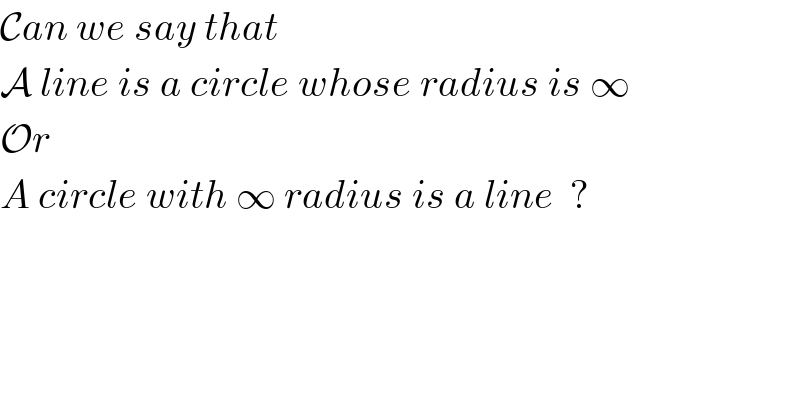
$$\mathcal{C}{an}\:{we}\:{say}\:{that} \\ $$$$\mathcal{A}\:{line}\:{is}\:{a}\:{circle}\:{whose}\:{radius}\:{is}\:\infty \\ $$$$\mathcal{O}{r} \\ $$$${A}\:{circle}\:{with}\:\infty\:{radius}\:{is}\:{a}\:{line}\:\:? \\ $$
Commented by Filup last updated on 19/Dec/15

$${A}\:\mathrm{line}\:\overset{\rightarrow} {{l}}=\infty\:\mathrm{is}\:\mathrm{like}\:\mathrm{a}\:\mathrm{vector} \\ $$$$\overset{\rightarrow} {{l}}\:\mathrm{moves}\:\mathrm{in}\:\mathrm{one}\:\mathrm{direction}\:\left(\mathrm{1D}\right). \\ $$$$\overset{\rightarrow} {{l}}\in\mathbb{R}^{\mathrm{1}} \\ $$$$ \\ $$$$\mathrm{A}\:\mathrm{circle}\:\mathrm{with}\:\mathrm{radus}\:\overset{\rightarrow} {{r}}=\infty\mathrm{is}\:\mathrm{similar}. \\ $$$$\mathrm{Except}\:\mathrm{a}\:\mathrm{circle}\:\mathrm{will}\:\mathrm{eventually}\:\mathrm{create} \\ $$$$\mathrm{tangents}\:\mathrm{facing}\:\mathrm{every}\:\mathrm{possible}\:\mathrm{direction} \\ $$$$\mathrm{in}\:\mathrm{what}\:\mathrm{we}\:\mathrm{can}\:\mathrm{call}\:\mathrm{a}\:\mathrm{2D}\:\mathrm{plane}. \\ $$$$\overset{\rightarrow} {{r}}\in\mathbb{R}^{\mathrm{2}} \\ $$$$ \\ $$$$\mathrm{This}\:\mathrm{is}\:\mathrm{just}\:\mathrm{what}\:\mathrm{i}\:\mathrm{think}.\:\mathrm{I}\:\mathrm{could}\:\mathrm{be} \\ $$$$\mathrm{wrong}. \\ $$
Commented by Filup last updated on 19/Dec/15

$${A}\mathrm{ctually},\:{a}\:{correction}\:{i}\:{want}\:{to}\:{point}\:{out}. \\ $$$$ \\ $$$$\overset{\rightarrow} {{r}}\notin\mathbb{R}^{\mathrm{2}} \\ $$$${the}\:\mathrm{circle}\:\overset{\rightarrow} {{c}}\in\mathbb{R}^{\mathrm{2}} . \\ $$$$\mathrm{The}\:\mathrm{radius}\:\mathrm{is}\:\mathrm{1D}.\:\overset{\rightarrow} {{r}}\in\mathbb{R}^{\mathrm{1}} \\ $$$$ \\ $$$${A}\:\mathrm{line}\:\mathrm{only}\:\mathrm{has}\:\mathrm{one}\:\mathrm{feature}: \\ $$$$\mathrm{its}\:\mathrm{length}\:\overset{\rightarrow} {{l}}\in\mathbb{R}^{\mathrm{1}} \\ $$$$ \\ $$$$\mathrm{A}\:\mathrm{circle}\:\left(\overset{\rightarrow} {{c}}\right)\:\mathrm{has}\:\mathrm{two}\:\mathrm{features}. \\ $$$$\mathrm{The}\:\mathrm{radius}\:\mathrm{and}\:\mathrm{the}\:\mathrm{circumference}. \\ $$$$\overset{\rightarrow} {{r}}\in\mathbb{R}^{\mathrm{1}} \:\:\:\:\:\:\:\:\:\:\:\:\overset{\rightarrow} {{c}}\in\mathbb{R}^{\mathrm{2}} \\ $$$$\mathrm{The}\:\mathrm{circle}\:\mathrm{itself}\:\mathrm{lies}\:\mathrm{within}\:\mathrm{a}\:\mathrm{2D}\:\mathrm{plane}. \\ $$$$\mathrm{The}\:\mathrm{radius}\:\mathrm{is}\:\mathrm{in}\:\mathrm{a}\:\mathrm{1D}\:\mathrm{plane} \\ $$
Commented by RasheedSindhi last updated on 19/Dec/15
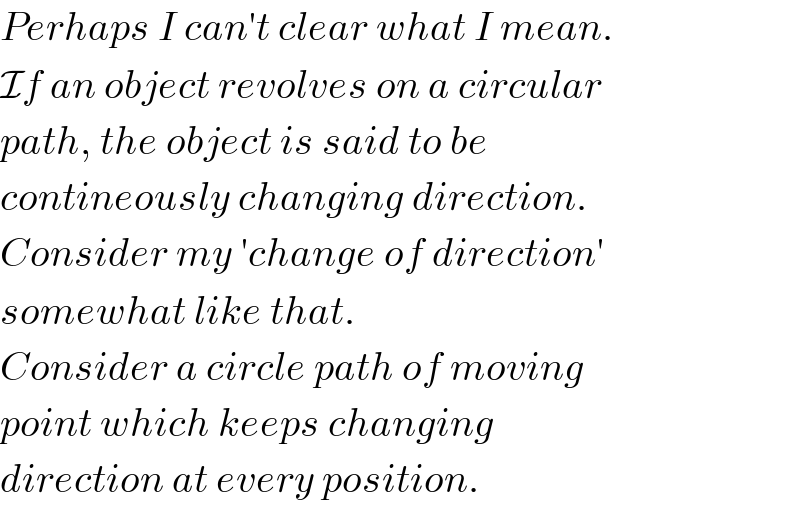
$${Perhaps}\:{I}\:{can}'{t}\:{clear}\:{what}\:{I}\:{mean}. \\ $$$$\mathcal{I}{f}\:{an}\:{object}\:{revolves}\:{on}\:{a}\:{circular} \\ $$$${path},\:{the}\:{object}\:{is}\:{said}\:{to}\:{be}\:\: \\ $$$${contineously}\:{changing}\:{direction}. \\ $$$${Consider}\:{my}\:'{change}\:{of}\:{direction}' \\ $$$${somewhat}\:{like}\:{that}. \\ $$$${Consider}\:{a}\:{circle}\:{path}\:{of}\:{moving} \\ $$$${point}\:{which}\:{keeps}\:{changing} \\ $$$${direction}\:{at}\:{every}\:{position}. \\ $$
Commented by prakash jain last updated on 19/Dec/15

$$\mathrm{Infinite}\:\mathrm{radius}\:\mathrm{means}\:{r}\rightarrow\infty. \\ $$$$\mathrm{What}\:\mathrm{is}\:\mathrm{the}\:\mathrm{area}\:\mathrm{of}\:\mathrm{line}?\:\mathrm{If}\:\mathrm{circle}\:\mathrm{is} \\ $$$$\mathrm{treated}\:\mathrm{as}\:\mathrm{line}. \\ $$
Commented by Rasheed Soomro last updated on 19/Dec/15
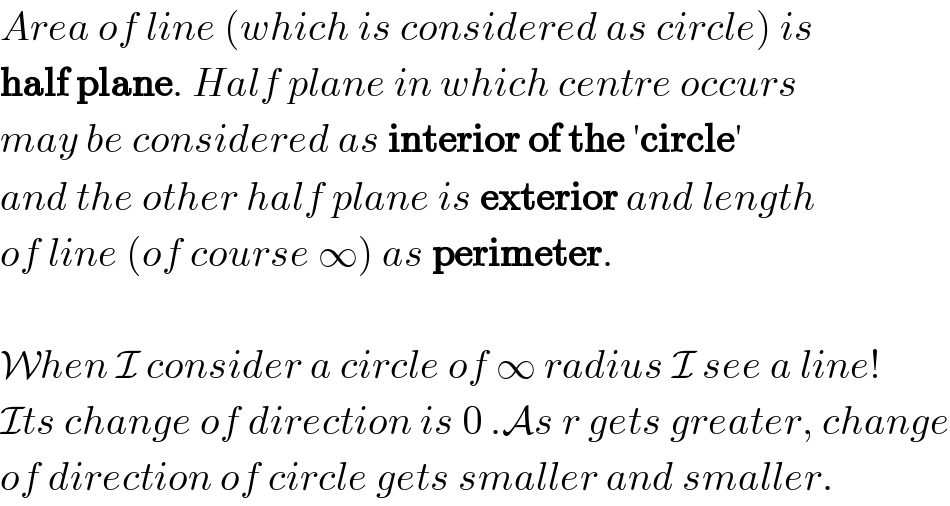
$${Area}\:{of}\:{line}\:\left({which}\:{is}\:{considered}\:{as}\:{circle}\right)\:{is} \\ $$$$\boldsymbol{\mathrm{half}}\:\boldsymbol{\mathrm{plane}}.\:{Half}\:{plane}\:{in}\:{which}\:{centre}\:{occurs} \\ $$$${may}\:{be}\:{considered}\:{as}\:\boldsymbol{\mathrm{interior}}\:\boldsymbol{\mathrm{of}}\:\boldsymbol{\mathrm{the}}\:'\boldsymbol{\mathrm{circle}}' \\ $$$${and}\:{the}\:{other}\:{half}\:{plane}\:{is}\:\boldsymbol{\mathrm{exterior}}\:{and}\:{length} \\ $$$${of}\:{line}\:\left({of}\:{course}\:\infty\right)\:{as}\:\boldsymbol{\mathrm{perimeter}}. \\ $$$$ \\ $$$$\mathcal{W}{hen}\:\mathcal{I}\:{consider}\:{a}\:{circle}\:{of}\:\infty\:{radius}\:\mathcal{I}\:{see}\:{a}\:{line}! \\ $$$$\mathcal{I}{ts}\:{change}\:{of}\:{direction}\:{is}\:\mathrm{0}\:.\mathcal{A}{s}\:{r}\:{gets}\:{greater},\:{change} \\ $$$${of}\:{direction}\:{of}\:{circle}\:{gets}\:{smaller}\:{and}\:{smaller}. \\ $$
Commented by prakash jain last updated on 19/Dec/15
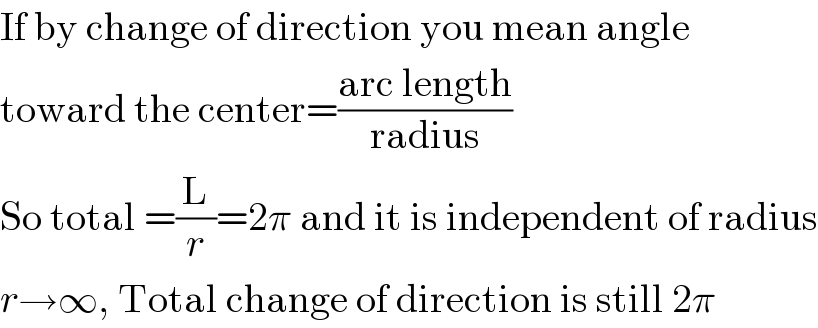
$$\mathrm{If}\:\mathrm{by}\:\mathrm{change}\:\mathrm{of}\:\mathrm{direction}\:\mathrm{you}\:\mathrm{mean}\:\mathrm{angle} \\ $$$$\mathrm{toward}\:\mathrm{the}\:\mathrm{center}=\frac{\mathrm{arc}\:\mathrm{length}}{\mathrm{radius}} \\ $$$$\mathrm{So}\:\mathrm{total}\:=\frac{\mathrm{L}}{{r}}=\mathrm{2}\pi\:\mathrm{and}\:\mathrm{it}\:\mathrm{is}\:\mathrm{independent}\:\mathrm{of}\:\mathrm{radius} \\ $$$${r}\rightarrow\infty,\:\mathrm{Total}\:\mathrm{change}\:\mathrm{of}\:\mathrm{direction}\:\mathrm{is}\:\mathrm{still}\:\mathrm{2}\pi \\ $$
Commented by RasheedSindhi last updated on 19/Dec/15

$${By}\:{change}\:{of}\:{direction}\:{I}\:{mean} \\ $$$${change}\:{of}\:{angle}\:{of}\:{tangents}. \\ $$$${Let}\:{the}\:{center}\:{of}\:{the}\:\:{circle}\:{is} \\ $$$${origin}\:{of}\:{the}\:{plane}\:{and}\:{the}\:{point} \\ $$$${of}\:{x}−{axis}\:{through}\:{which}\:{the} \\ $$$${circle}\:{passes}\:{is}\:{point}\:{A}. \\ $$$${At}\:{A}\:{the}\:{tangent}\:{is}\:{perpendicular} \\ $$$${to}\:{the}\:{x}−{axis}.{Let}\:{B}\:{is}\:{an}\:{other} \\ $$$${point}\:{of}\:{circle}.\:{Tangent}\:{on}\:{B} \\ $$$${will}\:{make}\:{angle}\:\left({say}\right)\:\theta\:{with} \\ $$$${x}−{axis}.\:{I}\:{mean}\:\:{by}\:'{change}\:{of} \\ $$$${direction}'\:{was}\:{keeping}\:{change}\:{of}\:{the} \\ $$$${value}\:{of}\:\theta. \\ $$
Commented by prakash jain last updated on 19/Dec/15
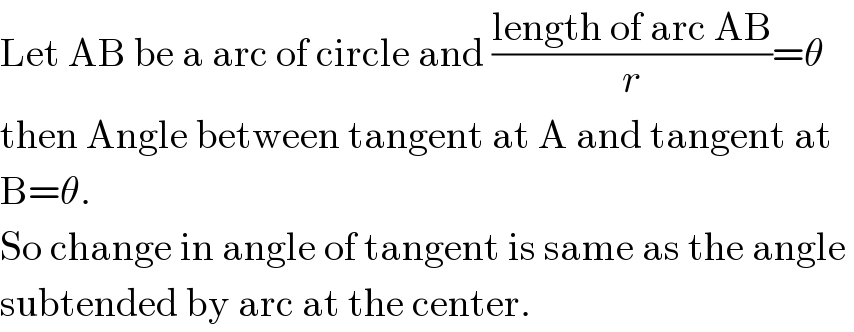
$$\mathrm{Let}\:\mathrm{AB}\:\mathrm{be}\:\mathrm{a}\:\mathrm{arc}\:\mathrm{of}\:\mathrm{circle}\:\mathrm{and}\:\frac{\mathrm{length}\:\mathrm{of}\:\mathrm{arc}\:\mathrm{AB}}{{r}}=\theta \\ $$$$\mathrm{then}\:\mathrm{Angle}\:\mathrm{between}\:\mathrm{tangent}\:\mathrm{at}\:\mathrm{A}\:\mathrm{and}\:\mathrm{tangent}\:\mathrm{at} \\ $$$$\mathrm{B}=\theta. \\ $$$$\mathrm{So}\:\mathrm{change}\:\mathrm{in}\:\mathrm{angle}\:\mathrm{of}\:\mathrm{tangent}\:\mathrm{is}\:\mathrm{same}\:\mathrm{as}\:\mathrm{the}\:\mathrm{angle}\: \\ $$$$\mathrm{subtended}\:\mathrm{by}\:\mathrm{arc}\:\mathrm{at}\:\mathrm{the}\:\mathrm{center}. \\ $$
Commented by prakash jain last updated on 19/Dec/15
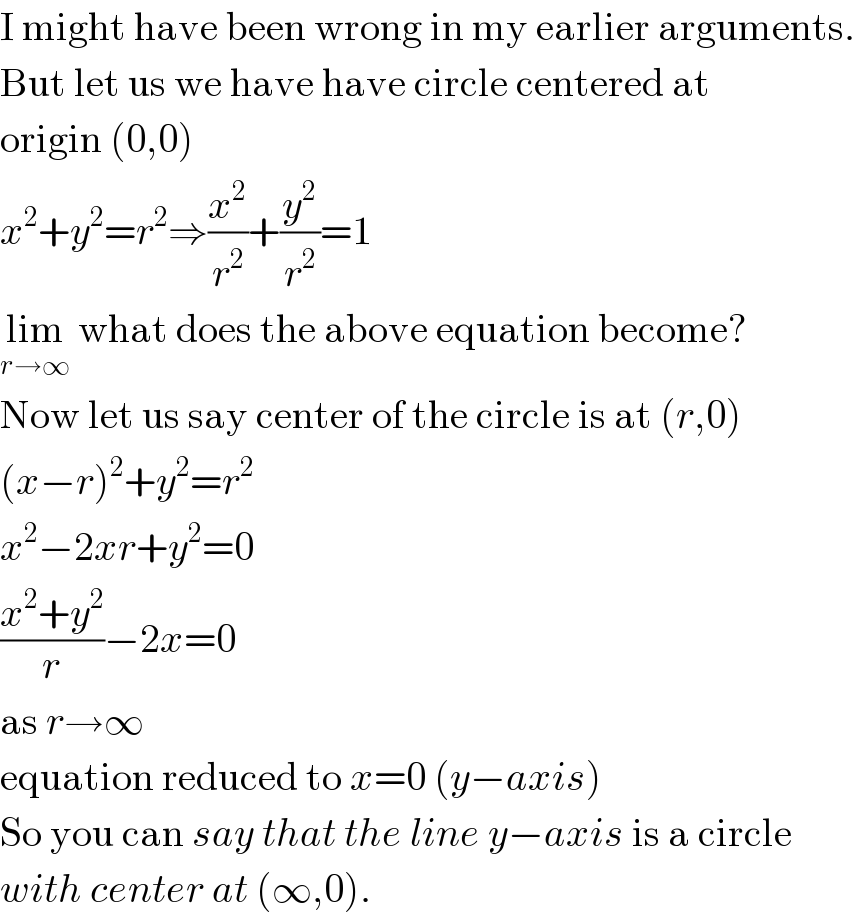
$$\mathrm{I}\:\mathrm{might}\:\mathrm{have}\:\mathrm{been}\:\mathrm{wrong}\:\mathrm{in}\:\mathrm{my}\:\mathrm{earlier}\:\mathrm{arguments}. \\ $$$$\mathrm{But}\:\mathrm{let}\:\mathrm{us}\:\mathrm{we}\:\mathrm{have}\:\mathrm{have}\:\mathrm{circle}\:\mathrm{centered}\:\mathrm{at} \\ $$$$\mathrm{origin}\:\left(\mathrm{0},\mathrm{0}\right) \\ $$$${x}^{\mathrm{2}} +{y}^{\mathrm{2}} ={r}^{\mathrm{2}} \Rightarrow\frac{{x}^{\mathrm{2}} }{{r}^{\mathrm{2}} }+\frac{{y}^{\mathrm{2}} }{{r}^{\mathrm{2}} }=\mathrm{1} \\ $$$$\underset{{r}\rightarrow\infty} {\mathrm{lim}}\:\mathrm{what}\:\mathrm{does}\:\mathrm{the}\:\mathrm{above}\:\mathrm{equation}\:\mathrm{become}? \\ $$$$\mathrm{Now}\:\mathrm{let}\:\mathrm{us}\:\mathrm{say}\:\mathrm{center}\:\mathrm{of}\:\mathrm{the}\:\mathrm{circle}\:\mathrm{is}\:\mathrm{at}\:\left({r},\mathrm{0}\right) \\ $$$$\left({x}−{r}\right)^{\mathrm{2}} +{y}^{\mathrm{2}} ={r}^{\mathrm{2}} \\ $$$${x}^{\mathrm{2}} −\mathrm{2}{xr}+{y}^{\mathrm{2}} =\mathrm{0} \\ $$$$\frac{{x}^{\mathrm{2}} +{y}^{\mathrm{2}} }{{r}}−\mathrm{2}{x}=\mathrm{0} \\ $$$$\mathrm{as}\:{r}\rightarrow\infty \\ $$$$\mathrm{equation}\:\mathrm{reduced}\:\mathrm{to}\:{x}=\mathrm{0}\:\left({y}−{axis}\right) \\ $$$$\mathrm{So}\:\mathrm{you}\:\mathrm{can}\:{say}\:{that}\:{the}\:{line}\:{y}−{axis}\:\mathrm{is}\:\mathrm{a}\:\mathrm{circle} \\ $$$${with}\:{center}\:{at}\:\left(\infty,\mathrm{0}\right).\: \\ $$
Commented by Rasheed Soomro last updated on 19/Dec/15

$$\mathcal{T}{hat}\:{is}\:{a}\:{point}\:{to}\:{think}! \\ $$
Commented by prakash jain last updated on 19/Dec/15
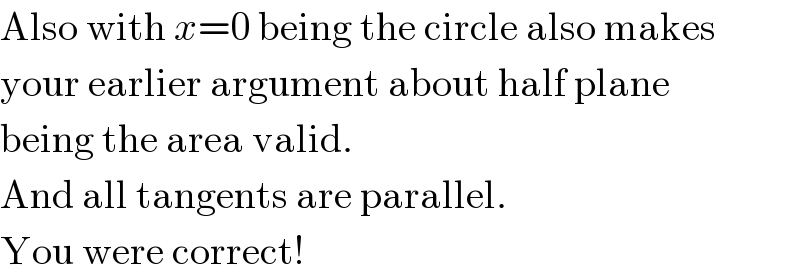
$$\mathrm{Also}\:\mathrm{with}\:{x}=\mathrm{0}\:\mathrm{being}\:\mathrm{the}\:\mathrm{circle}\:\mathrm{also}\:\mathrm{makes} \\ $$$$\mathrm{your}\:\mathrm{earlier}\:\mathrm{argument}\:\mathrm{about}\:\mathrm{half}\:\mathrm{plane} \\ $$$$\mathrm{being}\:\mathrm{the}\:\mathrm{area}\:\mathrm{valid}. \\ $$$$\mathrm{And}\:\mathrm{all}\:\mathrm{tangents}\:\mathrm{are}\:\mathrm{parallel}. \\ $$$$\mathrm{You}\:\mathrm{were}\:\mathrm{correct}! \\ $$
Commented by Rasheed Soomro last updated on 20/Dec/15

$${An}\:{other}\:{term}\:{in}\:{which}\:{we}\:{can}\:{clear} \\ $$$${our}\:{idea}\:{is}\:'{curveness}' \\ $$$${As}\:{radius}\:{of}\:{circle}\:{gets}\:{greater} \\ $$$${the}\:{curveness}\:{gets}\:{smaller}. \\ $$$${For}\:{r}=\mathrm{1},\:{for}\:{curve}\:{of}\:{unit}\:{length} \\ $$$${the}\:{curveness}\:{is}\:{obvious}.{But}\:{for} \\ $$$${r}=\mathrm{1000},{it}\:{is}\:{not}\:{so}\:{obvious}. \\ $$$${So}\:{we}\:{can}\:{say}: \\ $$$${r}\rightarrow\infty\:\Rightarrow\:{curveness}\rightarrow\mathrm{0} \\ $$$${or}\:{curveness}\rightarrow{straightness} \\ $$$${or} \\ $$$${circle}\rightarrow{line} \\ $$
